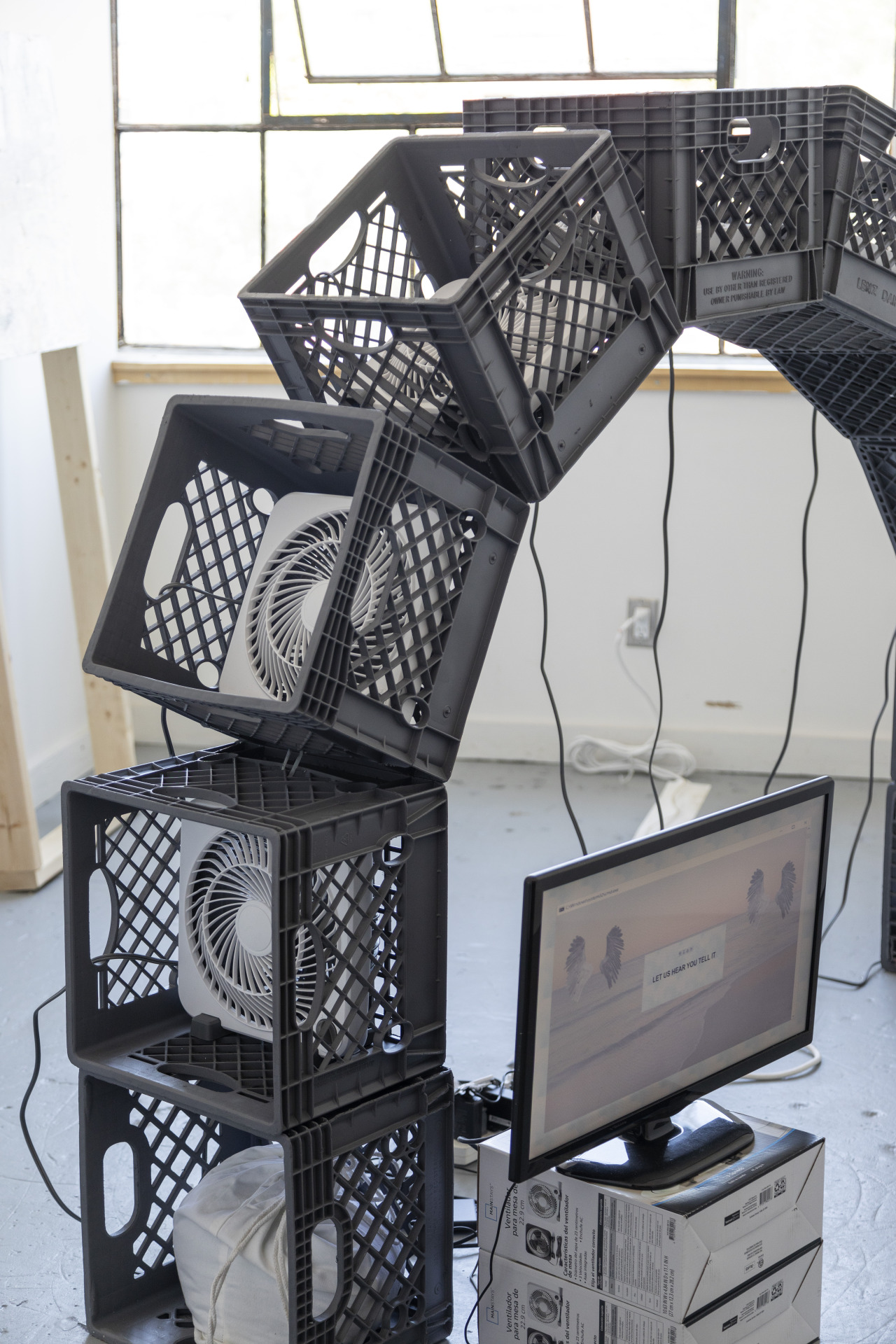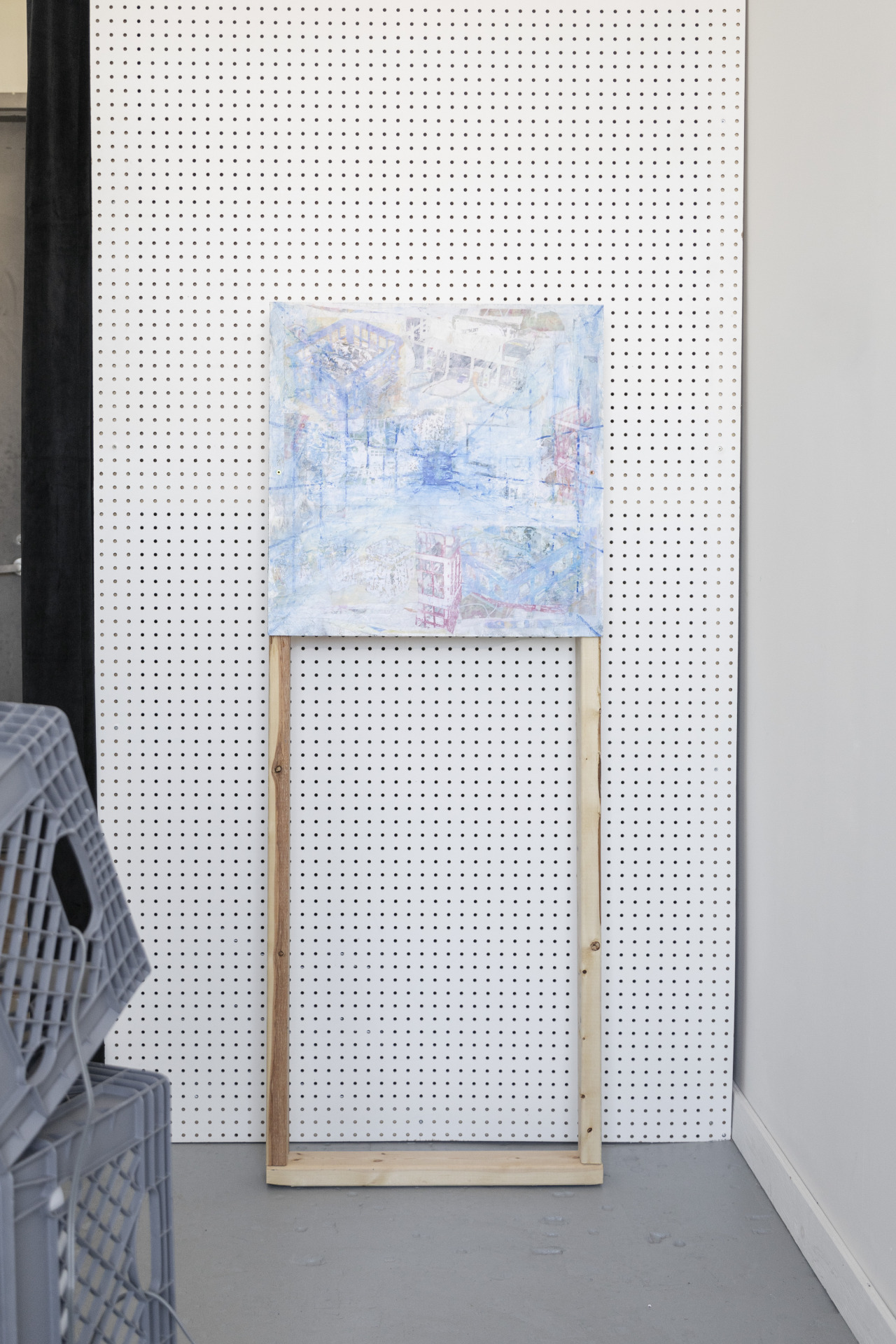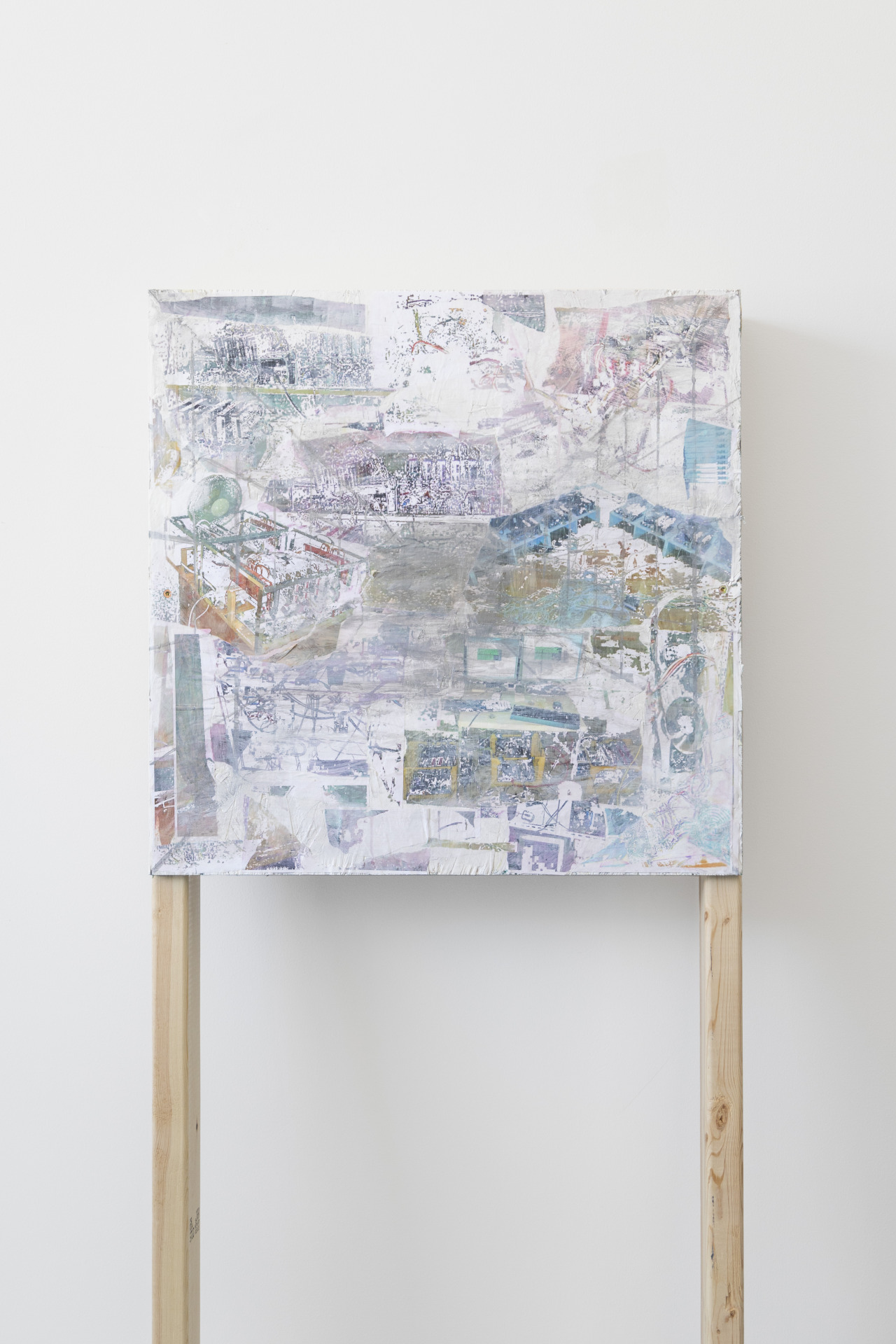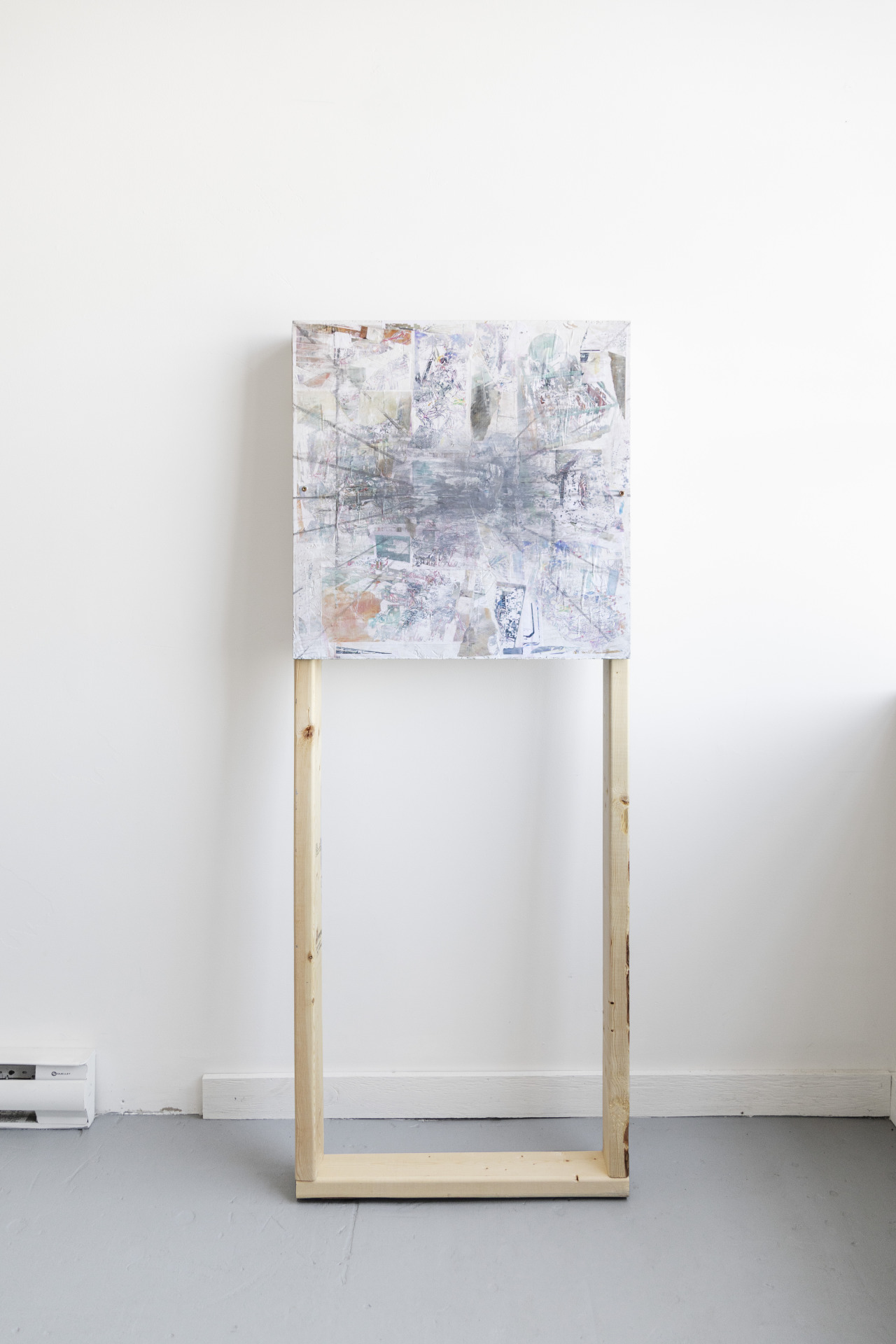Plainchant for Paper Hands
Galerie Éphémère, Montréal, QC, Canada
April - June 2022
In her text Medieval Saints and Modern Screens, Alicia Spencer-Hall writes, “Technology has not nullified potent religious belief. Instead, technology has become the language for expressing concerns and desires that were previously in the domain of the religious.”
Using the aesthetic language of Money Crates, or, DIY crypto-mining farms as the building blocks for an arcane portal, Plainchant for Paper Hands is an ode to the forever mixing of fantasy and religion within current human technologies.










Feels Like Heaven; Kara Güt: Plainchant For Paper Hands
by Morris Fox
Walking into Galerie Ephemere, the immediate impression/experience of Kara Güt’s Plainchant For Paper Hands is one of quietude. Three large rectangular wooden frames with portal paintings lean against the north and south walls of the gallery. A sculptural form created by a semi-circular formation of dark gray/black milk crates, connected to each other with zip-ties, form an archway in a diagonal across the floor. Each crate contains a cooling fan pointing outwards along the outer curve of the arch, making a drone as they emit a breeze strong enough to be felt on my skin as I circle around the space, almost as an invisible threshold that evokes a portal, a star-gate. The fan cords dangle inwards and down from the arch shape to a mundane power-cord that sprawls next to a stack of boxes for two of the fans, now a support pedestal for a monitor that acts as a “command center”, showing a video loop that performs as a string of commands, such as Let It Be Now, which counteracts the logic of a cryptorig where each command string informs the user of practical or economic concerns. Instead the command center evokes clouds and heavenly portals, and its aesthetics recollect angel-fire sites, Christian mingle and other religious or spiritual internet portals/gateways.
The materials gathered in Plainchant for Paper Hands recall "do-it-yourself" cryptocurrency mining rigs, often jury-rigged using readily available materials such as plastic crates, zip-ties, wall brackets and economical computing hardware and cooling fans and raspberry pi computer processors. These crypto mining rigs rely on economy and efficiency of material and process, while they are amateur productions run out of available space. The amateurship is a cultivation of other knowledge productions, outside of formal training or academia, and while they are structures created for the express purpose of financial gain, they are also at the same time sites of latent-desire, salvation and leisure—collapsing sites to which Kara Güt's installation brings immaterial intensifications, side-by-side these amateur knowledge productions by way of spiritual gnosis, a way of emptying out to let knowledge gained by divine insight and indirect means of communication in. Güt creates a space of minor architecture, where vacant sites of knowledge are “already out of balance, space is pressed out...listing toward the outside. Like a book no one is reading, a vacant building vibrates with unseen intensities...imagine emptiness recalibrated, space unfolded toward smooth and slippery and nonconforming use." (Stoner, 2012. 107)
Kara Güt's "portal paintings" are accumulating layers of perspectival space that collapse aspects of cyberspace, theology, and the remediation of nature through and as a speculative crypto-mine. This process-accretion is a tactic which infers peels and layers of non-place architecture within the pictorial framework. I trace a lineage to Alberti's window, a perspective device used by Renaissance painters where a window to the outside reveals nature and divine mystery through a framed geometry—the portal of a window. The portal paintings are suggestive of a browser window and painting frame, but break down the boundaries of each to question the transcendental tropes of cyber space and how we continue to frame nature through religion and technology. These "portal paintings”, also empty paintings/gnosis paintings, are components of the installation that perform with the experiencer an emptying of their subjecthood to accept something else, a gnosis or knowledge that comes from exterior-intimacy, the vibration of the visitor as their register passes into the painted field. This entry point portals one to an alternate space, neither in front of nor inside the painting, but caught between layers of knowledge, encapsulated as a method that dually erases or makes ghosts of their depicted spaces, or crypto-mining rigs, as well as their framing devices, which highlights their temporary and DIY construction.
Plainchant for Paper Hands turns the digital space into something physical and felt, to show the physical trappings and underpinnings/ infrastructure of the manifest digital. The installation’s video and support structures, chords, wires, package boxes, etc., remind the experiencer of this Möbian turn, and in the openness of the installation as much as it is smoke and mirror, the magician’s hand is shown. This installation plays with the mediumicity of its components, shared in the media of translation, as it carries the media, medium and meaning across and holds it within itself. To portal the portal becomes the metapoetics of the work, a poem about the poem. Translation, here seen as a reconstruction or relocation, is also an approximation; the space of the installation is not a simulation of its component media nor is it a direct criticism of its forms. Instead the work moves between media through mutating folds of meaning, its reference points veiled and transformed not only through the process of the work, but also by what a visitor themself brings.
The installation makes apparent manifestations of digital, ficto, and religious apparatuses. Layers are peeled back, revealing not more layers but that layers are already peeled back; this layering is an entanglement of feelings. Güt's work allows us to feel along the seams of the digital/physical divide, an interaction "with both a hidden realm within..." the mediated spaces we co-inhabit "and that which is hidden from us" by the systems of coding and interface that feel like a "kind of sorcery."(Anable, 2018, 65-66.) The visitor chooses their navigation with the work, there’s an ambivalence or angst that allows an open interpretation, as it becomes, through that affect, a collaboration, between the visitor and the work, between the appropriated language of things and the associations called into the installation from the mess of internet space; pushing it around, furthering the push and pull process that is continued with the visitor, a space that allows for speculative play.
Ambiguity, as an affective play within Plainchant for Paper Hands is achieved by a defamiliarization of the building blocks, of the raw materials of the work, where echo objects might seem like keys to understanding the work, but their deformative associations creates a reading of the installation for the viewer that is partially concealed or occulted. The reframing of the things within the space evokes a transformation, one that calls attention to the tropes and pitfalls of internet cultures, aesthetics and technologies, while also rubbing against and on them. The religious tones of the work intersect with and counterfeit its own mediation of crypto While a visitor might believe the work is a critique on cryptocurrency, it remediates its themes and materials to create something new out of the media at hand. This remediation is where one media and the resonance between “the transparent presentation of the real and the enjoyment of the opacity of media themselves” (Bolter and Grusin, 2000, 21) is folded into the turn away from the human/god view of nature as mirroring interface to technology, which subverts both the substance and quality as well as intended materials deployed. Alicia Spencer-Hall in Medieval Saints and Modern Screens says of this turn from the religious to the technological, “Technology has not nullified potent religious belief. Instead, technology has become the language for expressing concerns and desires that were previously in the domain of the religious.”(Spencer-Hall, 2018, 63)
The title’s plainchant suggests medieval melodies sung as a series of call and responses, relying on perfect fifths, which when sung in duets create the sensation of more than two voices, sensible though intangible. Here, the plainchant re-orchestrates gregorian midi freeware files, transposing voices into synthesized music that is spaced out, composed with pauses and moments for contemplation. This remix of what is experienced in real time with its digitized overlay, allows echoes of the past captured in synthesized registers to be experienced as sinister resonances, where “sound is a haunting, a ghost, a presence whose location in space is ambiguous and whose existence in time is transitory” (Toop, 2010, XV). Resonating between the visitor, the digital and real matrix of the works is a conjuring of a haunted harmony that constructs and operates as a felt in-between, a call and response of media attended by our contemporaneous need to be and bear witness, to have our desires heard.
In Kara Güt’s own words “we cling to the words and images of minor youtube deities and sing out into the void in hopes to receive an answer. With tags and @’s and private messages we plead for attention, hoping to be heard. In the human need to be witnessed by a god, we create our own hallucinated tones within blog posts about fanfictions involving characters from Minecraft roleplay servers, and 5-hour reaction videos about a web series no one has seen.” Plainchant for Paper Hands convokes religious spaces and practices aligned with the fantastic and speculative as world-building praxi, and entangles communal knowledge production, be they religious, fan-fictive or forum-based, to address how diverse media affect us. This ambiguous interplay, the speculative “what-if”, reconfigures the portal into something more and less, a transformative threshold of experience, meeting strangely at its interface, towards a spatial matrix that hangs out in the loser occult.
“The loser occult knocks the edifice down, hangs out in the rubble huffing, hallucinating, gossiping, making out, wasting time, confecting new and obscene humanoid and nonhumanoid forms.” (McSweeney, 2016. 177)
Citations
Anable, Aubrey. Playing With Feelings; Video Games and Affect. Minneapolis: University of Minnesota Press, 2018, 65-66.
Bolter, Jay David and Richard Grusin. Remediation: Understanding New Media. Cambridge: MIT Press, 2000. 21.
McSweeney, Joyelle. The Necropastoral: Poetry, Media, Occults. Anne Arbor: University of Michigan Press, 2015. 177.
Spencer-Hall, Alicia. Medieval Saints and Modern Screens: Divine Visions as Cinematic Experience. Amsterdam: Amsterdam University Press, 2018, 63.
Stoner, Jill. Toward a Minor Architecture. Cambridge: MIT Press, 2012, 107.
Toop, David. Sinister Resonance: The Mediumship of the Listener. New York: Continuum International Publishing, 2010, XV.